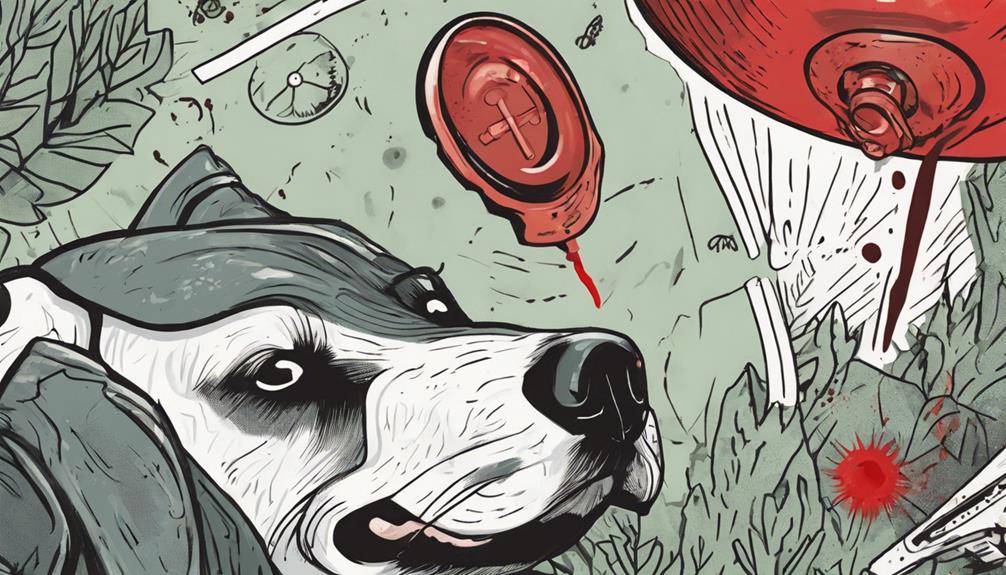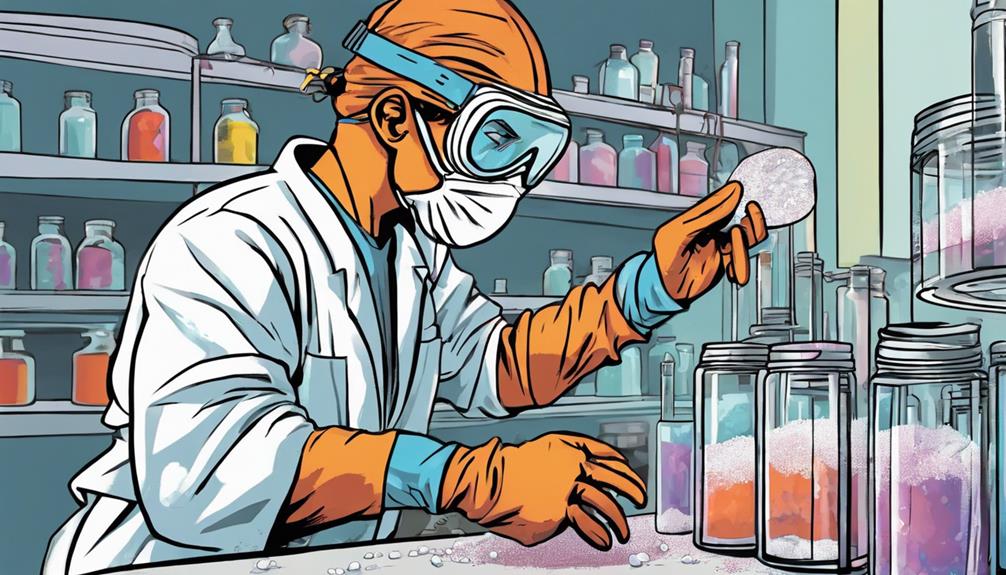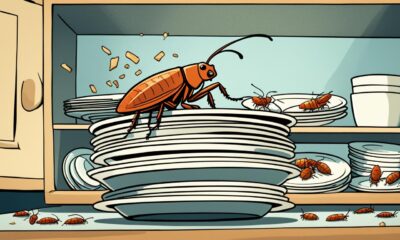Health and Wellness
Beauty Insight: What Are Panda Eyes and How to Deal With Them
Banish tired-looking eyes with a deeper understanding of panda eyes and discover effective solutions to reduce dark circles and puffiness.

Panda eyes, characterized by dark circles and puffiness under the eyes, can make you appear tired even when you're well-rested. The delicate skin around your eyes is prone to inflammation, and lack of sleep can cause it to appear dull. Additionally, genetic predisposition, poor eye care, and allergies can contribute to panda eyes. To combat this, prioritize self-care, maintain a balanced diet, and stay hydrated. Effective skincare treatments, such as MeLinr and NTFC, can also help reduce puffiness and dark circles. By understanding the causes and taking proactive steps, you can reduce the appearance of panda eyes and maintain healthy, radiant-looking skin around your eyes, and there's more to explore on this topic.
Key Takeaways
- Panda eyes, or dark circles, can be caused by genetic predisposition, poor eye care habits, allergies, and irritation, and can be a sign of underlying health problems.
- Poor eye care habits, such as rubbing eyes, lack of sleep, and neglecting sunscreen, contribute to panda eyes and can be improved with good habits.
- Natural remedies like cucumber eye masks, cold compress therapy, and chamomile tea bags can help reduce puffiness and dark circles.
- Effective skincare treatments like MeLinr and NTFC under-eye treatments can target the root causes of dark circles and improve blood circulation and collagen production.
- A healthy lifestyle, including prioritizing self-care, getting 7-8 hours of sleep, and maintaining a balanced diet, can help combat panda eyes and promote healthy eye skin.
Understanding Panda Eyes
Since you're reading this, chances are you've experienced panda eyes firsthand – those pesky dark circles that make you look tired even when you're not. Panda eyes, characterized by dark circles around the eyes, can greatly affect your appearance, making you appear fatigued even when you're well-rested.
The skin around your eyes is thin and delicate, making it prone to discoloration, which leads to the dark, puffy appearance we've come to know as panda eyes. Lack of sleep, for instance, can cause your skin to appear dull, accentuating those dark circles.
Understanding the causes of panda eyes is important in preventing and treating them effectively. It's vital to recognize that panda eyes aren't just a cosmetic issue but can also be a sign of an underlying health problem.
Causes of Panda Eyes

As you explore the causes of panda eyes, you'll discover that a combination of factors contributes to their development. Your genetic predisposition, poor eye care habits, and even allergic reactions or skin irritation can all play a role in the formation of dark circles under your eyes.
Genetic Predisposition Factor
Your genetic makeup can greatly influence your likelihood of developing panda eyes, with certain inherited traits making you more prone to dark circles. Genetic predisposition plays a significant role in causing panda eyes, and understanding your genetic makeup can help tailor treatments and prevention strategies to effectively manage this common issue.
| Inherited Traits | Impact on Panda Eyes |
|---|---|
| Thin under-eye skin | Increases visibility of dark circles |
| Increased melanin production | Enhances discoloration under the eyes |
| Visible blood vessels | Contributes to bluish or purplish hue |
| Family history of dark circles | Increases likelihood of developing panda eyes |
| Other genetic factors | Influences severity and persistence of panda eyes |
People with a family history of dark circles are more likely to experience them, indicating a genetic link in the manifestation of this cosmetic concern. Your genetic predisposition can influence the severity and persistence of panda eyes, making some individuals more susceptible to dark circles than others. Recognizing the role of genetic predisposition in panda eyes can help you take proactive steps to prevent or alleviate this common cosmetic concern.
Poor Eye Care
Poor eye care habits, including frequent rubbing, inadequate sleep, and neglecting to protect your skin from the sun, can wreak havoc on the delicate skin around your eyes, leading to panda eyes.
When you rub your eyes, you're damaging the delicate blood vessels under your skin, which can lead to dark circles around your eyes. Lack of sleep is another culprit, causing puffiness and discoloration. Furthermore, neglecting to protect your skin from the sun can trigger melanin production, darkening the skin under your eyes and making panda eyes more prominent.
To reduce the appearance of panda eyes, it's essential to prioritize good eye care habits. This includes getting adequate sleep, avoiding rubbing your eyes, and wearing sunscreen with at least SPF 30 to protect your skin from the sun.
Allergies and Irritation
Triggered by culprits like pollen, dust, or pet dander, allergies can cause inflammation and swelling around your eyes, leading to the appearance of panda eyes.
When you're exposed to allergens, your body reacts by releasing histamine, which causes blood vessels to swell, leading to dark circles.
Rubbing or scratching your eyes due to allergies can worsen panda eyes by increasing inflammation.
Allergic rhinitis, commonly known as hay fever, is a common cause of panda eyes due to nasal congestion and eye irritation.
Identifying and avoiding allergens, along with appropriate allergy medications, can help reduce panda eyes caused by allergies.
By taking steps to manage your allergies, you can minimize the appearance of panda eyes.
Natural Remedies for Panda Eyes

As you explore natural remedies for panda eyes, you'll want to try out a few simple yet effective techniques to reduce their appearance.
You can start by applying a cucumber eye mask, which is known for its soothing properties, or try cold compress therapy to reduce puffiness.
Additionally, you can use cooled chamomile tea bags as a compress to calm and relax the delicate skin around your eyes.
Cucumber Eye Mask
By incorporating a cucumber eye mask into your daily routine, you can harness the natural powers of cucumbers to reduce puffiness and dark circles around your eyes. This home remedy is particularly effective in tackling panda eyes, a common skin condition characterized by dark under-eye circles and puffiness.
The coolness of cucumbers helps constrict blood vessels and reduce swelling, making them ideal for soothing panda eyes. Cucumbers contain antioxidants and silica that can brighten skin and improve the appearance of dark circles.
To use a cucumber eye mask, simply apply cucumber slices or cucumber juice under your eyes for 10-15 minutes. This can provide a revitalizing and invigorating effect, helping to hydrate the skin, reduce inflammation, and promote a more youthful appearance.
Regular use of cucumber eye masks can lead to noticeable improvements in the appearance of panda eyes, making them an excellent addition to your skincare routine.
Cold Compress Therapy
How can you rapidly reduce the appearance of panda eyes and wake up your tired-looking under-eye area? One effective way is through cold compress therapy. By applying a cold compress for 10-15 minutes, you can constrict blood vessels and reduce swelling, which helps to diminish dark circles. This natural remedy can provide quick relief for panda eyes, and regular use can lead to a noticeable reduction in their appearance.
Cold compresses can be made from ice or chilled tea bags, making them a convenient and accessible solution. When you apply a cold compress, it improves blood circulation and tightens the skin around your eyes, giving you a more refreshed and revitalized look.
Chamomile Tea Bags
You can also harness the power of chamomile tea bags to combat panda eyes, leveraging their anti-inflammatory properties to soothe and invigorate your under-eye area. By placing cooled chamomile tea bags on your eyes for a few minutes, you can reduce puffiness and dark circles, giving your eyes a brighter and more youthful appearance.
As a natural remedy, chamomile tea bags are an excellent way to rejuvenate tired eyes. The anti-inflammatory properties of chamomile can soothe the delicate skin under your eyes, reducing the appearance of panda eyes. Regular use of chamomile tea bags can contribute to a noticeable difference, making them an excellent addition to your skincare routine.
With their calming and revitalizing properties, chamomile tea bags are a simple yet effective way to combat panda eyes and achieve a more radiant appearance.
Effective Skincare for Panda Eyes

When it comes to tackling panda eyes, incorporating effective skincare treatments into your daily routine can make a significant difference. Dark circles and under-eye circles can be a major concern, but with the right eye treatment, you can reduce their appearance and achieve a more youthful look.
MeLinr and NTFC under-eye treatments are popular choices for combating panda eyes. These treatments target the root causes of dark circles, puffiness, and fine lines. MeLinr delivers nutrients and antioxidants to improve blood circulation and stimulate collagen production, resulting in a brighter appearance.
NTFC, on the other hand, contains caffeine and green tea extract to reduce puffiness and improve the appearance of dark circles, leaving you with a refreshed look. Both treatments are safe, effective, and non-invasive, making them ideal for addressing panda eyes.
Combating Panda Eyes With Lifestyle

By adopting a lifestyle that prioritizes self-care and healthy habits, you can tackle panda eyes from a different angle and enhance the effectiveness of your skincare routine.
Getting sufficient sleep every night is important, as it can greatly reduce the appearance of dark circles. Aim for 7-8 hours of sleep to help improve blood circulation, which can brighten the skin around the eyes.
A balanced diet rich in vitamins C and E can also improve skin health, minimizing the appearance of dark circles. Staying hydrated by drinking enough water throughout the day can prevent dehydration-related panda eyes.
Additionally, managing stress through relaxation techniques like yoga or meditation can contribute to a healthier, more refreshed appearance. Don't forget to protect the delicate skin around the eyes from sun damage with sunglasses and sunscreen.
By incorporating these healthy habits into your daily routine, you can reduce the appearance of panda eyes.
However, if you still experience persistent panda eyes, it may be a sign of an underlying medical condition, so consult with a dermatologist to rule out any underlying issues.
Advanced Treatments for Panda Eyes

To tackle persistent panda eyes, consider advanced treatments that specifically target dark circles and puffiness, offering a more dramatic transformation than lifestyle changes alone. MeLinr and NTFC under-eye treatments are two advanced solutions that can help.
| Treatment | Benefits |
|---|---|
| MeLinr | Delivers nutrients and antioxidants to reduce inflammation, stimulate collagen production, and improve blood circulation for a brighter appearance. |
| MeLinr | Provides a more youthful and refreshed look. |
| NTFC | Contains caffeine and green tea extract to reduce puffiness and improve the appearance of dark circles. |
| NTFC | Offers a lightweight, silky serum for a refreshed look. |
These advanced treatments address the root causes of panda eyes, offering safe, effective, and non-invasive options to improve the overall appearance of the under-eye area. By combating dark circles and puffiness, MeLinr and NTFC under-eye treatments can help you achieve a well-rested and youthful look. These popular choices can help you say goodbye to panda eyes and hello to a brighter, more radiant you.
Maintaining Healthy Eye Skin

You can take proactive steps to maintain healthy eye skin, and it all starts with a few simple habits. To reduce the appearance of panda eyes, eye bags, and dark circles, prioritize getting sufficient sleep, staying hydrated, and eating a balanced diet.
These habits will help you maintain healthy skin around your eyes. Additionally, using eye creams rich in ingredients like vitamin C, retinol, and peptides can improve the appearance of your under-eye area.
Protecting your skin from UV damage with sunscreen can also prevent premature aging and dark circles. Managing stress through relaxation techniques like meditation or exercise can promote overall skin health.
Frequently Asked Questions
How to Deal With Panda Eyes?
You deal with panda eyes by using cold compresses, trying under-eye treatments, and making lifestyle changes like getting enough sleep and staying hydrated to minimize their appearance.
What Is the Reason for Panda Eyes?
You're wondering what causes those pesky dark circles under your eyes, known as panda eyes. Well, it's likely due to a combination of factors like lack of sleep, allergies, stress, genetics, and dehydration that's causing them to appear.
How Do You Cure Panda Eyes Fast?
You can cure panda eyes fast by applying cold compresses, using eye creams with retinol, vitamin C, and peptides, staying hydrated, getting enough sleep, and protecting your skin from sun exposure.
Does Stress Cause Panda Eyes?
You're wondering if stress causes panda eyes, and the answer is yes! Stress disrupts your sleep, increases cortisol, and worsens circulation, making dark circles more prominent, so finding ways to manage stress is essential.
How Can I Deal with Panda Eyes and Banana Rolls at the Same Time?
To deal with panda eyes and banana rolls at the same time, consider getting aesthetic enhancement for the banana roll definition. Consult with a skincare specialist for targeted treatments and invest in high-quality concealers and skincare products. Prioritize adequate sleep, hydration, and a healthy diet to minimize the appearance of both concerns.
Conclusion
As you reflect on your journey to combat panda eyes, remember that a healthy eye skin routine is like a delicate dance – every step, from natural remedies to advanced treatments, counts.
By harmonizing your skincare, lifestyle, and treatments, you'll be saying goodbye to dark circles and hello to brighter, more radiant eyes.
By taking control, you're not just covering up panda eyes, you're rewriting the script to a brighter, more confident you.

Health and Wellness
Dog Owner's Guide: How to Safely Remove a Tick From Your Pet
Tackle tick removal with confidence: learn the simple steps to safely extract ticks from your pet and reduce the risk of tick-borne diseases.

To safely remove a tick from your pet, start by preparing a well-lit area with fine-tipped tweezers or a tick removal hook, gloves, antiseptic, and a sealed container. Grasp the tick close to the skin and pull upwards in one smooth motion. Clean the bite area with antiseptic and monitor for signs of infection. Dispose of the tick properly and watch for post-removal symptoms like fever, lethargy, and loss of appetite. By following these steps, you'll reduce the risk of diseases like Lyme disease, anaplasmosis, and Rocky Mountain spotted fever. Now, learn how to prevent future tick encounters and identify tick-borne diseases.
Key Takeaways
- Use fine-tipped tweezers or a tick removal hook to safely remove the tick, grasping it close to the skin.
- Pull the tick straight out with steady pressure, avoiding crushing it, and clean the bite area with antiseptic after removal.
- Prepare a well-lit area with necessary tools and a calm pet for efficient removal, ensuring a safe environment with protective gloves.
- Monitor the bite area for signs of infection, redness, swelling, or irritation, and seek veterinary advice if necessary.
- Properly dispose of the tick by flushing it down the toilet or sealing it in a bag to prevent reattachment.
Understanding the Risks of Ticks
Living in wooded or grassy areas, you're likely familiar with the pesky critters that lurk in the underbrush, waiting to latch onto your pet and transmit diseases that can be fatal if left untreated. Ticks are notorious for spreading tick-borne diseases, such as Lyme disease, anaplasmosis, and Rocky Mountain spotted fever, which can be devastating to your pet's health. These diseases can cause a range of symptoms, from fever and joint pain to more severe complications if left untreated.
As a pet owner, understanding the risks associated with ticks and taking preventative measures to minimize the transmission of diseases is crucial. Regularly checking your pet for ticks and using preventative treatments can significantly reduce the risk of tick-borne illnesses. Early detection is vital in preventing the transmission of diseases from ticks to pets.
Preparing for Tick Removal

As you prepare to remove a tick from your pet, it's important to gather essential supplies and choose the right tool for the job.
You'll want to select a fine-tipped tweezers or a tick removal hook that will allow you to grasp the tick as close to your pet's skin as possible.
Gather Essential Supplies
Before you start the tick removal process, gather the essential supplies you'll need to guarantee a safe and successful procedure. Having the right tools will make the process less stressful for you and your pet.
Here are the essential supplies you'll need:
- Fine-tipped tweezers or a tick-removal tool to safely Remove a Tick from your pet's skin
- Gloves to protect yourself during the removal process
- Pet-friendly antiseptic and disinfectant to clean the bite area
- A sealed container to dispose of the tick after removal
- A tick hook (optional) to aid in safe and efficient removal of ticks from your pet
Remember to use tweezers or a tick-removal tool to grasp the tick as close to your pet's skin as possible. This will ensure a safe and successful removal. By having these essential supplies ready, you'll be well-prepared to Remove a Tick from your pet quickly and safely.
Choose the Right Tool
When it comes to removing a tick from your pet, selecting the right tool is vital, and you'll typically reach for fine-tipped tweezers or a specialized tick removal tool. These tools are designed to remove the tick safely and effectively, reducing the risk of infection and minimizing the chances of twisting or jerking the tick during removal.
Using the right tool is essential, as it prevents squeezing the tick or leaving mouthparts behind, which can lead to infection. Fine-tipped tweezers or a tick removal tool allow you to grasp the tick as close to your pet's skin as possible, making it easier to remove the entire tick.
Make sure to confirm the tool is clean and ready for use before starting the removal process. Having the correct tool on hand can make the tick removal process quicker and less stressful for your pet.
Prepare a Safe Environment
To guarantee a smooth and safe tick removal process, prepare a well-lit area with good visibility and all necessary tools within easy reach. This will allow you to focus on the task at hand without any distractions.
Before starting, make sure you have the following essentials:
- A well-lit area with good visibility to effectively perform the tick removal process
- All necessary tools, such as fine-tipped tweezers or tick removal tools, ready and within easy reach
- Protective gloves to prevent direct contact with the tick and reduce the risk of infection
- A plan to keep your dog calm and comfortable during the removal process to minimize stress and ensure safety
- A secure position for your dog to prevent sudden movements that could complicate the tick removal procedure.
Removing the Tick Safely

Now that you're prepared to remove the tick from your pet, it's vital to focus on the safe removal process.
You'll need to choose the right tool for the job, prepare your pet for the procedure, and then carefully remove the tick.
Choose the Right Tool
Choose a fine-tipped pair of tweezers or a specialized tick removal tool to guarantee a safe and effective removal process. When it comes to removing a tick from your pet, using the right tool is essential. You'll want to select a tool that allows you to grasp the tick close to the skin, making sure that you remove the entire tick without leaving any parts behind.
Here are some key considerations when choosing the right tool for tick removal:
- Use fine-tipped tweezers or a specialized tick removal tool to ensure a safe and effective removal process
- Avoid using everyday objects like fingers or nails, as these can cause the tick to break apart and increase the risk of infection
- Opt for a tool that allows you to grasp the tick close to the skin, reducing the risk of leaving mouthparts behind
- Consider using a tool specifically designed for tick removal, as these are often designed with safety and effectiveness in mind
- Make sure to clean the tool with antiseptic after use to prevent the spread of infection
Prepare Your Pet
When preparing your pet for the safe removal of the tick, it's crucial to have a steady and gentle hand. Before you start, make sure your pet is calm and comfortable.
Make sure to grasp the tick close to the skin with your fine-tipped tweezers, being careful not to squeeze the tick's body to prevent any discomfort or stress to your pet. This will help avoid any bacteria or saliva from entering your pet's bloodstream. Once you've grasped the tick, you're ready to remove it.
After removal, clean the bite area with antiseptic to disinfect and prevent infection. Finally, remember to monitor your pet closely for any signs of illness or infection after removing the tick.
Remove the Tick
Using fine-tipped tweezers, you'll grasp the tick as close to your pet's skin as possible, pulling upwards in one smooth motion. This guarantees the tick is removed completely, reducing the risk of infection or disease transmission. Make sure to pull straight upwards, avoiding twisting or jerking the tick, which can cause mouthparts to break off and remain in your pet's skin.
For a safer and easier removal, consider using a tick removal hook specifically designed for this purpose.
After removal, take the following steps:
- Clean the bite area with antiseptic or soap and water to prevent infection.
- Store the tick in rubbing alcohol or a sealed container in case it needs to be identified later.
- Avoid crushing the tick, as this can cause it to release its saliva, increasing the risk of disease transmission.
- Wear gloves to protect yourself from potential tick-borne diseases.
- Wash your hands thoroughly after handling the tick.
Post-Removal Care and Monitoring

After safely removing a tick from your pet, you'll need to focus on post-removal care and monitoring to prevent infection and guarantee your pet's recovery.
Cleaning the bite area with antiseptic or soap and water is important to prevent infection. Monitor the removed tick bite site for any signs of redness, swelling, or irritation, as these can be indicative of infection.
If the tick's head is stuck, avoid poking or prodding the area to prevent further complications. Properly dispose of the tick by placing it in rubbing alcohol to make sure it can't reattach or spread disease.
Keep an eye out for post-removal symptoms such as fever, lethargy, or loss of appetite, and seek veterinary advice if you notice any concerning reactions in your pet. Providing post-removal care involves monitoring your pet's behavior and physical condition closely.
Preventing Future Tick Encounters

You can greatly reduce the risk of future tick encounters by taking proactive measures to protect your pet and its environment. By being proactive, you can minimize the risk of tick-borne diseases and future tick encounters.
Here are some essential steps to prevent future tick encounters:
- Regularly use tick prevention treatments like spot-on treatments or tick collars recommended by your vet.
- Conduct thorough tick checks on your pet after outdoor activities to prevent future tick encounters.
- Maintain a clean environment in your home and yard to reduce the risk of tick infestations.
- Avoid areas known to be tick-infested when walking or playing with your pet.
- Consider vaccinating your dog against tick-borne diseases to further prevent future tick encounters.
Identifying and Managing Tick-Borne Diseases

Understanding tick-borne diseases is crucial for recognizing symptoms early, as timely intervention can greatly impact treatment outcomes and your pet's quality of life. Rocky Mountain Spotted Fever (RMSF), a common tick-borne disease, has a fatality rate exceeding 30-40%. You should be aware that over 60% of RMSF cases are reported in states such as North Carolina, Tennessee, and Oklahoma. Did you know that cats can test positive for RMSF without showing signs, and ticks can hide in areas cats can't reach during grooming?
Here's a breakdown of tick-borne diseases, transmission times, and pathogens:
| Disease | Transmission Time | Pathogen |
|---|---|---|
| RMSF | 3-48 hours | _Rickettsia rickettsii_ |
| Lyme Disease | 36 hours | _Borrelia burgdorferi_ |
| Anaplasmosis | 12-24 hours | _Anaplasma phagocytophilum_ |
| Ehrlichiosis | 3-48 hours | _Ehrlichia spp._ |
| Babesiosis | 12-48 hours | _Babesia spp._ |
When managing tick-borne diseases, it's important to understand that ticks transmit pathogens through saliva during feeding due to their barbed feeding tubes and cement-like secretion. By recognizing the signs and symptoms of tick-borne diseases, you can take prompt action to protect your pet's health.
Frequently Asked Questions
How to Safely Remove a Tick From a Dog?
You're wondering how to safely remove a tick from your dog. To do so, grasp the tick close to the skin with fine-tipped tweezers, pull upwards, and clean the area afterward to prevent infection.
Can I Use Rubbing Alcohol to Get a Tick off My Dog?
"Are you really going to risk pushing the tick's saliva into your dog's skin? No! You can't use rubbing alcohol to get a tick off your dog; instead, use it to disinfect tools and clean the bite area after removal."
Will Hydrogen Peroxide Make a Tick Back Out?
You're wondering if hydrogen peroxide will make a tick back out, but unfortunately, it's not a recommended method. Hydrogen peroxide can irritate the tick, causing it to regurgitate pathogens into your pet, increasing disease transmission risks.
Do I Need to Clean My House After Finding a Tick on My Dog?
You don't need to deep clean your house after finding a tick on your dog unless you suspect an infestation; vacuuming and washing your dog's bedding should be enough to remove any stray ticks or eggs.
Conclusion
As you've now learned the ins and outs of safely removing ticks from your pet, remember that vigilance is key. One missed tick can lead to a world of trouble.
Stay alert, stay proactive, and stay informed – the battle against tick-borne diseases is ongoing, and you're your pet's best defense.
Health and Wellness
What Is Monocalcium Phosphate and Why Is It in Your Food?
Fascinating insights on monocalcium phosphate reveal why it's a crucial ingredient in your food, offering texture, nutrients, and more.

Monocalcium phosphate is in your food to improve texture, add nutrients, and aid in processes like leavening. It acts as a leavening agent in baked goods and enriches products like cereals and cheese with essential nutrients. In the baking industry, it enhances quality and reacts with baking soda for ideal texture. Animals benefit from it too, as it supports growth, bone strength, and digestion. For the environment, efforts to extract it sustainably are ongoing. Safety measures are important due to phosphorus concerns. Discover how this common additive benefits your food in various ways.
Key Takeaways
- Acts as a leavening agent in baked goods, providing texture and volume.
- Enriches food with essential nutrients like phosphorus and calcium.
- Found in various food products like baked goods, cereals, and processed meats.
- Enhances quality and appearance of baked goods by controlling carbon dioxide release.
- Assists in nutrient absorption and promotes bone strength in animals.
Uses of Monocalcium Phosphate
Monocalcium phosphate serves various purposes in different industries, ranging from being a leavening agent in baked goods to a source of essential nutrients in animal feed. In baked goods, it acts as a leavening agent, helping dough rise and creating a light, fluffy texture in cakes, bread, and pastries.
Additionally, it's used in animal feed as an important source of calcium and phosphorus, promoting growth and health in livestock, especially in poultry and pigs. This mineral supplement is essential for plant growth in the fertilizer industry, enhancing soil quality and supporting healthy plant development.
Furthermore, monocalcium phosphate plays a role in dental health, strengthening tooth enamel in dental products like toothpaste and mouthwash. It's also utilized as a buffering agent in pharmaceuticals and a clarifying agent in brewing processes.
The versatility of monocalcium phosphate makes it a valuable food additive with various essential functions in different sectors.
Dietary Sources of Monocalcium Phosphate

Commonly found in a variety of food products, dietary sources of monocalcium phosphate include baked goods, cereals, jams, jellies, cheese products, and processed meats. This compound, used extensively in the food industry, serves as a leavening agent in baked goods, contributing to their texture and rise. Additionally, monocalcium phosphate enriches these products with essential nutrients such as phosphorus and calcium, which are crucial for overall health. Its presence in a wide range of food items guarantees that consumers receive these nutrients in an easily accessible form. Below is a table showcasing some common dietary sources of monocalcium phosphate:
| Food Product | Monocalcium Phosphate Content |
|---|---|
| Baked Goods | High |
| Cereals | Moderate |
| Jams & Jellies | Low |
| Cheese Products | Moderate |
| Processed Meats | Low |
Benefits for Baking Industry

In the baking industry, the utilization of monocalcium phosphate as a leavening agent greatly enhances the quality and texture of various baked goods.
When monocalcium phosphate is used, it reacts with baking soda to release carbon dioxide, which is essential for creating a light and fluffy texture in cakes, bread, and pastries.
By controlling the release of carbon dioxide in combination with other leavening agents, ideal baking results are achieved.
The presence of monocalcium phosphate is vital for ensuring that baked goods have the desired texture, volume, and appearance.
It plays a key role in making sure that the final products turn out light, airy, and visually appealing.
Therefore, in the baking industry, the incorporation of monocalcium phosphate as a leavening agent is fundamental for obtaining the ideal texture and quality in a variety of baked goods.
Importance in Animal Nutrition

Monocalcium phosphate is essential in animal nutrition, assisting in nutrient absorption, supporting growth, and development in livestock like poultry and pigs.
It plays a critical role in promoting bone strength, eggshell quality, and digestion, contributing to overall animal well-being.
Nutrient Absorption Benefits
Enhancing nutrient absorption in animal nutrition is essential for promoting ideal growth and overall health in livestock. Monocalcium phosphate aids in the absorption of essential minerals like calcium and phosphorus, important for bone health, muscle function, and overall development. By facilitating improved digestion and nutrient utilization, it contributes to enhanced milk production, quality eggshell formation, and overall well-being in animals.
| Nutrient Absorption Benefits | Importance in Animal Nutrition |
|---|---|
| Bone Health | Essential for development |
| Muscle Function | Critical for movement |
| Milk Production | Enhanced by nutrient absorption |
| Eggshell Quality | Improved through proper nutrition |
| Overall Health | Supported by ideal nutrient absorption |
Monocalcium phosphate is widely used in animal nutrition to ensure that livestock receive the necessary nutrients for proper growth, development, and reproductive performance. Its role in enhancing nutrient absorption underscores its significance in promoting the health and vitality of animals.
Growth and Development Support
Supporting growth and development in animals, particularly in livestock, involves making sure they receive essential nutrients like calcium and phosphorus for best health and vitality. Monocalcium phosphate plays an important role in animal nutrition by providing these necessary nutrients.
It's essential for promoting growth, bone development, and overall health in various livestock species. When added to livestock feed, monocalcium phosphate enhances bone health, digestion, reproduction, and vitality.
By incorporating monocalcium phosphate into animal diets, farmers can guarantee that their animals receive the proper nutrition needed for best growth and development. This nutrient not only supports healthy bone structure but also contributes to improved reproduction and overall vitality in animals.
As a result, monocalcium phosphate is a crucial component in animal nutrition, helping to enhance the well-being and productivity of livestock by providing essential elements like calcium and phosphorus for their growth and development.
Environmental Impact and Sustainability

To address the environmental impact and promote sustainability of monocalcium phosphate, efforts are being made to improve fertilizer management practices and extract phosphorus from waste streams.
The excessive use of monocalcium phosphate in fertilizers can lead to nutrient pollution, soil erosion, and habitat destruction. By enhancing fertilizer management practices, the negative effects on ecosystems can be reduced.
Extracting phosphorus from waste streams helps in utilizing resources efficiently and lessening the demand for new phosphate sources. Monocalcium phosphate contains essential nutrients like phosphorus and calcium, which are essential for crop growth and increasing agricultural yields.
Sustainable practices aim to balance the benefits of monocalcium phosphate with mitigating its environmental impacts. Considering environmental factors is critical for maintaining ecosystem health and promoting agricultural sustainability.
Safety and Handling Considerations

Proper handling and safety measures are essential when working with monocalcium phosphate to prevent potential risks to health and the environment. While classified as non-hazardous in Material Safety Data Sheets, it's important to adhere to recommended guidelines for safe handling. This includes wearing protective clothing to minimize exposure.
Excessive phosphorus present in monocalcium phosphate can lead to environmental issues such as algae blooms if not managed properly. Proper disposal following local regulations is essential to prevent environmental contamination.
Frequently Asked Questions
Is Monocalcium Phosphate in Food Bad for You?
Having monocalcium phosphate in food isn't necessarily bad for you. It's considered safe by regulators and supports bone health. Remember to consume it in moderation. Transparency in labeling guarantees you know what's in your food.
What Are the Hazards of Monocalcium Phosphate?
Hazards of monocalcium phosphate are minimal when consumed in moderation. Regulatory bodies declare it safe, and rigorous handling guarantees safety. Excessive intake may lead to health issues, emphasizing moderation. Companies follow safety procedures.
Is Calcium Phosphate Good or Bad for You?
Calcium phosphate is good for you in moderation. It supports bone health, nerve function, and muscle contractions. Consult a healthcare provider before taking supplements to confirm it benefits your overall health without causing harm.
What Are the Dangers of Phosphates in Food?
Phosphates in food pose risks to your health, such as kidney damage, cardiovascular disease, and bone health issues. Excessive intake can disrupt hormones and affect your kidneys. Be cautious about these additives in processed foods.
Conclusion
In summary, monocalcium phosphate is a versatile ingredient found in various foods and plays an essential role in baking and animal nutrition.
Like a silent worker behind the scenes, it quietly enhances the texture and nutritional value of products we consume every day. Its significance can't be overstated, making it a key component in the food industry and beyond.
Remember, next time you enjoy a freshly baked treat or feed your pet, monocalcium phosphate is there, working its magic.
Health and Wellness
Hidden Dangers: Why Eating Raisins Could Be Harmful
Behind the innocent appearance of raisins lies a toxic threat to your dog's health, and the consequences can be devastating.

You might think raisins are harmless, but they can be toxic to dogs, causing acute kidney failure that can be fatal if not treated promptly. Even a small handful can be harmful, and symptoms include vomiting, diarrhea, lethargy, and increased thirst. Recognizing these symptoms and taking immediate action is important to prevent severe kidney damage. Keeping raisins out of reach and educating family members about the risks are essential preventive measures. By understanding the dangers of raisins, you can take steps to protect your dog and guarantee their safety. Now, discover more about the risks and consequences of raisin toxicity.
Key Takeaways
- Raisins can cause acute kidney failure in dogs, even in small amounts, and prompt veterinary attention is crucial if ingestion is suspected.
- Symptoms of raisin toxicity in dogs include vomiting, diarrhea, lethargy, and increased thirst, and recognizing these signs is vital for timely intervention.
- Grapes, currants, wine, grape juice, and grape seeds can also be toxic to dogs, and keeping these products out of reach is essential.
- Dehydration from raisin toxicity can be life-threatening, and immediate veterinary attention is necessary to prevent severe kidney damage or failure.
- Preventive measures like storing raisins securely and educating family members about the risks can help keep dogs safe and healthy.
The Toxic Truth About Raisins
As a dog owner, you may be unaware that something as seemingly harmless as a handful of raisins can be a ticking time bomb for your furry friend. Raisins, a common snack for humans, contain unknown substances that can lead to kidney failure in dogs.
What's alarming is that even small amounts can be harmful, regardless of your dog's breed, age, or size. It's important to understand the risks associated with raisins to keep your pet safe.
Consuming raisins can cause a range of symptoms in dogs, including vomiting, diarrhea, lethargy, and increased thirst. If you suspect your dog has ingested raisins, it's vital to seek immediate veterinary attention. Prompt action can help prevent severe health complications.
By recognizing the dangers of raisins, you can take proactive measures to protect your dog. Keep those tasty treats out of reach, and educate your family members about the risks. Remember, it's always better to be safe than sorry when it comes to your dog's health.
Stay informed, and keep your furry friend safe from the toxic truth about raisins.
Raisin Poisoning in Dogs Explained

You may think you know what happens when a dog ingests raisins, but the reality of raisin poisoning is more complex and dangerous than you might imagine. Raisin toxicity is a serious concern for dog owners, as even a small amount can be harmful to dogs of any size or breed.
If your dog ingests raisins, it can lead to acute kidney failure, which can be fatal if left untreated. Symptoms of raisin poisoning include vomiting, diarrhea, lethargy, and increased thirst.
If you suspect your dog has ingested raisins, it's vital to seek immediate veterinary attention. Don't wait for symptoms to appear, as prompt treatment is critical to prevent severe kidney damage.
Preventive measures, such as keeping raisins out of reach, are also essential to protect your dog from potential harm. By being aware of the dangers of raisin toxicity, you can take steps to guarantee your dog's safety and avoid a potentially life-threatening situation.
Deadly Dangers of Grape Products

Understanding the risks associated with other grape products like grapes, currants, and wine is vital for your dog's health, and it's important to be aware of the potential dangers of these seemingly harmless foods. While raisins are a well-known hazard, other grape products can be toxic to dogs as well.
| Grape Product | Toxicity Risk | Precautions |
|---|---|---|
| Grapes | High | Keep out of reach, monitor for hidden sources |
| Currants | High | Store in secure containers, supervise snacks |
| Wine | High | Dispose of responsibly, avoid spills |
| Grape Juice | Moderate | Limit access, clean up spills promptly |
| Grape Seeds | Low | Still toxic, exercise caution around seeds |
Grapes or raisins, even in small amounts, can be harmful to dogs, causing acute kidney failure. It's crucial to recognize the risks associated with these products and take preventive measures to ensure your dog's safety. By being aware of the potential dangers and taking steps to prevent accidental ingestion, you can help keep your dog safe and healthy.
Symptoms of Raisin Toxicity

Recognizing the symptoms of raisin toxicity in your dog is vital, as they can manifest rapidly, often within 12-24 hours of ingestion. If you suspect your dog has ingested raisins, it's important to monitor their behavior and health closely.
Some common signs of raisin toxicity include:
- Vomiting and diarrhea
- Increased urination and dehydration
- Loss of appetite and lethargy
- Halitosis (bad breath)
If left untreated, raisin toxicity can lead to severe kidney damage. In severe cases, dehydration can be life-threatening.
To assess dehydration, gently lift the skin at the back of your dog's neck to check for elasticity. If the skin doesn't spring back quickly, your dog may be dehydrated.
In such cases, it's crucial to induce vomiting and seek immediate veterinary attention to prevent further kidney damage. Prompt action can greatly improve your dog's chances of recovery.
Protecting Your Dog From Harm

To safeguard your furry friend, it's important to take preventive measures to keep raisins out of reach and create a raisin-free environment. As a responsible dog owner, you must understand that raisins are toxic to dogs and can cause kidney failure even in small amounts. Keeping raisins out of your dog's reach is the first step in protecting them from harm. This includes storing raisins in secure containers, avoiding leaving raisin-containing food or snacks unattended, and educating family members about the dangers of raisins to dogs.
Additionally, it's vital to be aware of the symptoms of raisin toxicity in dogs, which include vomiting, diarrhea, abdominal pain, and lethargy. If you suspect your dog has ingested raisins, seek immediate veterinary attention to prevent severe health complications.
Safe Alternative Treat Options

Luckily, you can easily substitute raisins with a variety of healthy and tasty treats that are safe for your furry friend to enjoy. As you're aware, grapes and raisins can be toxic to dogs, so it's essential to find nutritious treat alternatives that provide your dog with essential nutrients and antioxidants.
Here are some safe and healthy options you can try:
- Carrots: Crunchy and sweet, carrots are a great snack for dogs, rich in fiber and vitamins.
- Apples (without seeds): Apples are a tasty and healthy treat, but be sure to remove the seeds, which can be toxic.
- Blueberries: Packed with antioxidants, blueberries are a nutritious treat that dogs love.
- Peanut butter (without xylitol): A tasty and healthy spread, peanut butter is a great alternative to raisins, as long as it's free from xylitol.
Raisin Toxicity Symptoms to Watch

If you suspect your dog has ingested raisins, it's crucial to monitor them closely for signs of toxicity, which can appear within hours of consumption.
As a dog owner, it's important to recognize the symptoms of raisin toxicity to guarantee prompt veterinary attention. Common signs of toxic reactions include vomiting, diarrhea, increased thirst, and abdominal pain. You may also notice lethargy, decreased appetite, and dehydration.
In severe cases, kidney failure can occur, even after consuming a small amount of raisins. This is because raisins contain a toxic compound that can cause kidney damage.
Keep a close eye on your dog's behavior and watch for additional signs like bad breath, decreased urination, and weakness. If you suspect raisin toxicity, don't hesitate to seek immediate veterinary care.
What to Do in an Emergency

When you suspect your dog has ingested raisins, it's crucial to act quickly and take the necessary steps to guarantee their safety.
You'll need to recognize the symptoms of raisin poisoning, such as vomiting, lethargy, and increased thirst, and immediately seek emergency veterinary care.
Raisin Poisoning Symptoms
You must act quickly if your dog shows signs of raisin poisoning, as prompt veterinary attention can greatly impact the outcome. Raisin poisoning symptoms in dogs can manifest within 12-24 hours of ingestion and may include vomiting, diarrhea, increased thirst, and lethargy. If you suspect your dog has ingested raisins, monitor them closely for these signs.
Watch for these critical indicators of raisin toxicity:
- Vomiting: A common symptom of raisin poisoning, which can lead to dehydration.
- Diarrhea: Another sign of raisin toxicity, which can cause dehydration and electrolyte imbalance.
- Increased thirst: A possible indicator of kidney damage, which can lead to kidney failure in dogs.
- Lethargy: A general sign of illness, which can be a symptom of exact toxic reactions.
Dehydration and decreased urine output are indicators of potential kidney damage.
It's crucial to seek immediate veterinary attention to prevent kidney failure and ensure your dog receives proper treatment. Remember, prompt action can have a significant impact on your dog's prognosis.
Emergency Vet Visits
In a raisin poisoning emergency, swift action is vital, so head to the vet clinic immediately, calling ahead to alert them to your dog's situation. If your dog has ingested raisins, don't hesitate – every minute counts.
While en route to the clinic, contact the vet or a pet poison hotline to get guidance on what to do next. Avoid inducing vomiting without professional guidance, as this can sometimes do more harm than good.
If your dog shows signs of distress or unconsciousness, seek help promptly. Even if your dog appears fine, an urgent visit to the vet is necessary for proper care. Don't wait for symptoms to appear; the sooner your dog receives treatment, the better their chances of recovery.
Treatment Options Available
Your veterinarian will quickly spring into action to treat raisin toxicity, administering medications and inducing vomiting if necessary to minimize the toxic effects. The goal is to prevent kidney failure, which can be fatal.
In terms of treatment options available, your veterinarian may employ the following measures:
- Decontamination: inducing vomiting, administering activated charcoal to absorb the toxins, and providing intravenous fluid therapy to flush out the system.
- Medication: administering medications to manage symptoms and support kidney function.
- Monitoring: closely monitoring your dog's kidney function through regular bloodwork to assess the severity of the toxicity.
- Hospitalization: hospitalizing your dog for at least 48 hours to ensure close monitoring and prevent further complications.
It's essential to remember that prompt treatment is vital in preventing severe kidney damage or failure. By seeking immediate veterinary attention, you can increase your dog's chances of a successful recovery.
Veterinary Care for Raisin Poisoning

Navigating the complexities of veterinary care for raisin poisoning, it's crucial to recognize the symptoms of toxicity, which will guide your emergency treatment options.
You'll need to work closely with your veterinarian to develop ongoing care strategies tailored to your pet's specific needs.
Recognition of Symptoms
Identifying the symptoms of raisin poisoning in your dog is vital, since they can manifest swiftly, often within 12-24 hours of ingestion. As a responsible pet owner, it's important to recognize the warning signs to guarantee prompt veterinary care.
Common symptoms of raisin poisoning include:
- Vomiting and diarrhea
- Increased thirst and dehydration
- Loss of appetite and lethargy
- Halitosis (bad breath)
If you suspect your dog has ingested raisins, monitor them closely for these symptoms. Dehydration levels can be checked by gently lifting the skin at the back of the dog's neck for elasticity. Decreased urination and kidney shutdown can be indicators of severe kidney damage.
Emergency Treatment Options
If you suspect your dog has ingested raisins, immediate action is essential, and prompt veterinary care is necessary to prevent severe kidney damage and potential death. As a responsible dog owner, it's important to understand the emergency treatment options available to guarantee the best possible outcome for your pet.
Upon arriving at the veterinary clinic, your dog will likely undergo emergency treatment to induce vomiting and administer activated charcoal to prevent further toxin absorption. Intravenous fluid therapy may also be initiated to support kidney function and aid in toxin elimination. In severe cases, hospitalization for at least 48 hours may be necessary for close monitoring and intensive care.
Bloodwork will be conducted to assess your dog's kidney function and overall health status. Immediate veterinary intervention is vital to increase the chances of a positive outcome for dogs affected by raisin poisoning. Don't hesitate to seek veterinary care – prompt action can make a significant difference in your dog's recovery.
Ongoing Care Strategies
You'll need to work closely with your veterinarian to develop an ongoing care strategy that supports your dog's recovery from raisin poisoning and helps prevent long-term kidney damage. This collaborative approach guarantees your dog receives the necessary care to reach a full recovery.
During the recovery period, regular bloodwork is necessary to assess and manage kidney health. Your veterinarian will monitor your dog's progress, making adjustments to their treatment plan as needed.
To prevent future incidents, it's vital to take the necessary precautions to keep raisins out of your dog's reach.
Here are some crucial steps to take:
- Secure food storage: Store raisins and other toxic foods in sealed containers or high shelves.
- Supervise mealtime: Always supervise your dog during meals to prevent scavenging.
- Educate family members: Inform all family members about the dangers of raisins and ensure they understand the necessary precautions.
- Keep an emergency kit ready: Have a pet poison emergency kit on hand, including activated charcoal and other essential supplies.
Preventing Future Raisin Accidents

By taking proactive steps, you can greatly decrease the risk of raisin-related accidents and guarantee a safe environment for your pet. To prevent future accidents, educate family members and visitors about the dangers of raisins and the importance of keeping them away from pets. This will make certain that everyone is on the same page and can help prevent accidental ingestion.
Store raisins and raisin-containing products out of reach of pets, and be cautious with foods that may contain raisins, such as baked goods, cereals, and trail mixes. Regularly check your surroundings for any dropped or misplaced raisins that pets could come into contact with.
Additionally, consult with a veterinarian to create a pet-safe environment free from raisin-related risks and safeguard your pet's well-being. By following these steps, you can greatly reduce the risk of raisin-related accidents and create a safe haven for your pet.
Frequently Asked Questions
Is There a Downside to Eating Raisins?
You might think raisins are a healthy snack, but you're wrong; eating too many can cause digestive issues, bloating, and discomfort due to their high sugar and fiber content, making them a less-than-ideal choice.
How Many Raisins a Day Is Safe?
As you ponder the daily raisin limit, imagine a ticking time bomb in your dog's belly, waiting to trigger kidney failure; the harsh truth is, there's no safe amount, and even one raisin can be disastrous.
Are Dried Out Raisins Safe to Eat?
You're wondering if dried out raisins are safe to eat, and the answer is yes, they're still safe for human consumption, but be cautious not to overconsume them, as they're high in sugar and calories.
Can Raisins Cause Blockage?
You're wondering if raisins can cause blockages, and the answer is yes, they can. Eating large quantities can lead to gastrointestinal blockages, causing vomiting, abdominal pain, and lethargy, which require immediate veterinary attention.
Conclusion
You've probably been enjoying raisins as a healthy snack, but the truth is, they can be deadly for your furry friends. It's ironic that something so small and harmless-looking can cause so much harm.
By now, you know the risks and what to do in case of an emergency. Remember, a single raisin can be toxic, so keep them out of reach of your pets.
Be vigilant, and your furry friends will thank you.
-

 Culinary Delights2 months ago
Culinary Delights2 months agoBanish Roaches: Get Rid of Cockroaches in Kitchen Cabinets
-

 Finance and Technology2 months ago
Finance and Technology2 months agoThreshold Delivery Explained: Quick Guide
-

 Health and Wellness2 months ago
Health and Wellness2 months agoAesthetic Enhancement: What Exactly Is a Banana Roll?
-

 Finance and Technology2 months ago
Finance and Technology2 months agoUnderstanding What is an Adaptation Apex
-

 Health and Wellness2 months ago
Health and Wellness2 months agoUnderstanding What is an Exchange Surgery
-

 Culinary Delights2 months ago
Culinary Delights2 months agoMonocalcium Phosphate Guide – Uses & Benefits
-

 Sports and Recreation2 months ago
Sports and Recreation2 months agoOn the Green: Understanding the Role of a Forecaddie
-

 Culinary Delights2 months ago
Culinary Delights2 months agoDiscover What is Kippered Beef: A Tasty Treat














